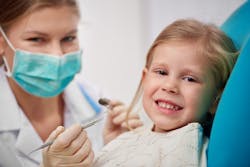Home-care products for pediatric dental care
Whether you’re a provider or parent, deciding on oral health products for children can be tricky. There are so many available that it can be overwhelming. Also, every child is different, so not every product is going to work the same. As a dental hygienist, I find that having a list of go-to home-care products improves my patients' oral health and makes oral hygiene education more personal to kids and their parents.
Here are some of products I love to recommend. They span from orthodontics to fluoride to everything in between.
Fluoride additives
For kids at high risk for caries and ones who always seem to have cavities, a fluoride additive to their routine is a must. Personally, I always start with recommending Act fluoride rinse (actoralcare.com).
When presenting this product, it is important to stress that the child must swish for at least 15 seconds before spitting out. Also, to get the best results the child should not rinse or eat for at least 30 minutes. When I explain the reasoning behind this, a lightbulb goes off with the parents. It's one of those things they otherwise wouldn't think about.
Sometimes after a few visits it may appear that a fluoride rinse is insufficient. In these cases, I ask the parent if the child is using the rinse daily. If the parent assures me the child is, then I will change my recommendation to a fluoridated toothpaste prescription such as Colgate PreviDent (colgate.com).
In discussing PreviDent, I give similar instructions as with the fluoride rinse: brush and then spit out excess toothpaste, but do not rinse or eat for 30 minutes. I explain that a pea-size amount is enough, and that if used properly the tube will last a good three months. Understandably, parents sometimes think "the more toothpaste the better." They want to cover the toothbrush with paste—even for their own brushing. This is why it is so important to educate, because you never know the knowledge base each person has.
For patients who don’t brush...or for patients who do a quick scrub and swear they're doing it twice a day...or for those who just plain won’t listen, I recommend Listerine Smart Rinse (listerine.com). I love this product for children. I use it for my niece and nephew when they stay over. They love it too—they think it’s a game!
I'll share with you a success story in recommending this product. I told one parent to have her son rinse with Listerine Smart Rinse when he was done brushing. I explained that the color of the mouthwash would "stick" to the plaque, and her son would be able to see just how much he was missing. At the six-month follow-up appointment, it was amazing to see the difference in the child's attitude toward brushing and the quality of his oral hygiene. What's more, his mom said that this product had completely changed how they did their morning and night routines. What used to be a screaming match turned into a positive reinforcement game. Not only were his teeth cleaner, the at-home routine was much better!
As an aside, did you know Listerine Smart Rinse will also color plaque on the tongue? Given this, I think the product would be great in other settings. One idea is to use this product in group homes and nursing homes. Think about the settings in which you practice and get creative!
Kids with braces
I always used to groan when I saw that my schedule had patients with orthodontic appliances. I just didn’t know how to tackle braces efficiently and effectively without getting frustrated. But then GumChucks (gumchucks.com) came along.
GumChucks is a flossing product that helps orthodontic patients floss their teeth like regular teeth. As kids probably tell you, flossing with braces is difficult. The biggest compliant I get is that it takes too long, it's hard to get the hang of, and it hurts to floss with a threader. GumChucks gets around this by suspending the floss between two long handles (the "chucks," as in "nunchucks"). There is a notch on one end of the handle to go under the bracket so you can floss just like you would a regular tooth. The handles also make it easier to access the back teeth. You can string a decent amount of floss between the handles, which allows you to go through the whole mouth easily and minimize bacteria transfer. I tell patients to rinse off the floss when plaque and blood show on the floss.
I have both a stainless steel and plastic set of GumChucks in my op. I use the plastic ones to show patients what they can get for home care and how to use them.
Toothbrushes
When it comes to toothbrushes, I always recommend Oral-B Stages toothbrushes (oralb.com) and safety toothbrushes for children who are ages six months to two years. I educate parents about the Stages toothbrushes so they are sure to get the right size head for the child's mouth. Too often I see children using a brush that is way too big. This makes brushing a difficult task.
When parents say their child has a bad gag reflex when brushing, I ask two questions: "What size toothbrush is being used?" and "How much toothpaste is being put on the brush?" While the child might have a gagging problem to a certain extent, these two factors play a huge role.
Toothpaste
For toothpaste, I love to recommend Orajel Safety Toothpaste (orajel.com). It's fluoride-free and safe to swallow. I always tell parents not to move to a children’s toothpaste with fluoride until these conditions are met: (1) the child knows that toothpaste can't be swallowed and (2) the child knows how to spit the toothpaste out. Otherwise, the fluoride will make the stomach sick.
Colgate and Oral-B both have great toothpastes for children, too. If recommending, just reiterate to only use a small, pea-size amount. For patients who have multiple stainless steel crowns or orthodontic appliances, I recommend Arm & Hammer products (armandhammer.com/oral-care) to help neutralize the pH of the saliva and minimize caries risk and plaque retention.
When my patients leave, along with their goody bags I like to give them two-minute sand timers or recommend an app to help them brush longer.
Other considerations
Every family can find products that fit their needs. We just need to be there to help steer them in the right direction. It's always good to remember that finances are an important part with compliance. I don’t often recommend power brushes or water flossers because my patients’ families can’t afford it. You know your clientele. If these products are within the budget and you think they will be beneficial, then that’s amazing. I think our goal should always be to educate and recommend. If patients take any pieces of that with them home, I think we are doing good!
About the Author
Katie Melko, MSDH, RDH
Katie Melko, MSDH, RDH, is a public health hygienist at Community Health Center Inc. She graduated from Fones School of Dental Hygiene at the University of Bridgeport in 2016 with an MSDH. She has practiced dental hygiene since 2009.


